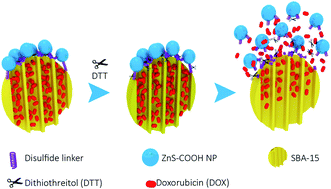Doxorobicin as cargo in a redox-responsive drug delivery system capped with water dispersible ZnS nanoparticles
Abstract
In this work, we have prepared and investigated a redox-responsive drug delivery system (DDS) based on a porous carrier. Doxorubicin (DOX), a chemotherapy medication for treatment of different kinds of cancer, was used as a model drug in the study. DOX was loaded in ordered hexagonal mesoporous silica SBA-15, a nanoporous material with good biocompatibility, stability, large pore size and specific surface area (SBET = 908 m2 g−1, VP = 0.79 cm3 g−1, d = 5.9 nm) and easy surface modification. To prepare the redox-responsive system, cystamine derivative ligands, with redox active disulphide linkers were grafted onto the surface of SBA-15. To ensure no significant premature release of DOX from the porous system, thioglycolic acid modified ZnS nanoparticles (ZnS–COOH NPs) were used as pore capping agents. The grafted redox-responsive cystamine derivative ligand containing disulphide linkers was bonded by a peptide bond to the thioglycolic acid groups of ZnS–COOH NPs, capping the pores. Once the disulphide bond was cleaved, the ZnS–COOH NPs caps were released and pores were opened to deliver the DOX cargo. The dithiol bond was cleavable by redox active molecules such as dithiothreitol (DTT) or glutathione, the concentration of which in cancer cells is 4 times higher than in healthy cells. The redox release of DOX was studied in two different media, physiological saline solution with DTT and saline without DTT. The prepared DDS proved the concept of redox responsive release. All samples were characterised by powder X-ray diffraction (XRD), transition electron microscopy (TEM), nitrogen adsorption/desorption at 77 K, Fourier-transform infrared spectroscopy (FTIR), thermal analysis and zeta potential measurements. The presence of semiconducting ZnS nanoparticle caps on the pore openings was detected by magnetic measurements using SQUID magnetometry showing that such cargo systems could be monitored using magnetic measurements which opens up the possibilities of using such drug delivery systems as theranostic agents.



 Please wait while we load your content...
Please wait while we load your content...